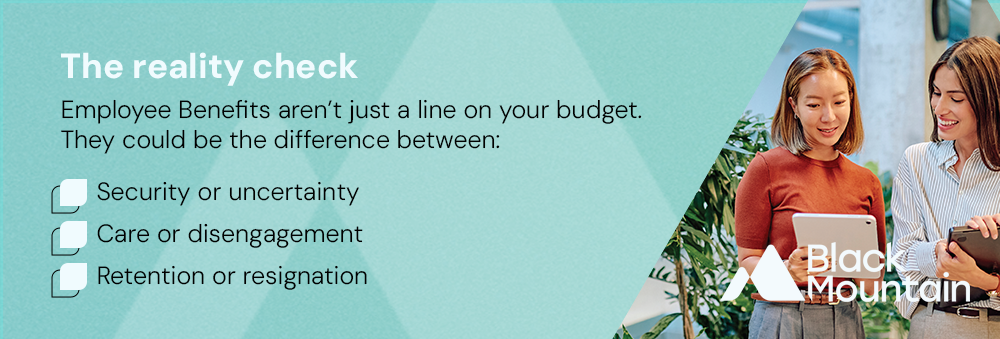
Will Your Employee Benefits Deliver When They’re Needed Most
Why Your Employee Benefits Strategy Matters When It’s Needed Most
When your employees really need to use their employee benefits, not the “tick box” ones, for support, will they do the job that is expected? It doesn’t matter if it’s a SME or larger business, it is the one questions we ask employers to think seriously about when discussing their employee benefits strategy.
It’s easy to fall into the trap of thinking benefits are just another cost, they are! One of your employees is diagnosed with cancer, signed off long-term sick, or devastatingly, passes away, that’s when the structure and suitability of those benefits is tested.
I’ve worked within employee benefits for over 23 years, and I’ve seen most things. I have been on all sides, the insurer, adviser, employer and, sadly, the recipient. The best benefit strategies are not necessarily the most expensive. More often than most, they are well-thought-through, and most aligned with your employee needs.
Adam Riley, Employee Benefits Director
We talked recently about a benefits structure which on the face of it was good, but it wasn’t doing what the employer wanted to achieve. Never be afraid to rip up the offering, start fresh, and rebuild. Too often we see packages which have never been properly reviewed, always gone through renewal, maybe made a few tweaks here and there, but rarely has the total offering been looked at to make sure it still does what is needed.
Critical Illnesses Can Strike at Any Age, Is Your Employee Benefits Strategy Ready?
Many serious illnesses don’t discriminate by age. According to Group Risk Development (GRiD), 24% of claims paid through Group Critical Illness policies in 2023 were to individuals under the age of 40, nearly one in four employees. It’s no longer enough to assume that Group Critical Illness cover is something only needed later in life. The numbers say otherwise, and we need to listen.
Source: Group Risk Development
Personally, these numbers are not far from what we see with friends. Cancer, heart attacks, strokes etc. Your benefits should work together, not in isolation. A robust benefits package is about understanding how they interact and support one another. After talking with an employer the other day, the other day, and their example reflects how misaligned benefits are in a lot of cases.
- An employer has Group Income Protection in place, but the company sick pay ends in week 12, the policy kicks in at 26 weeks. What happens in the gap? That’s 14 weeks of uncertainty for the employee and let’s not forget, the employer too.
- A Health Cash Plan is a great day-to-day benefit. But if PMI is offered with an excess, employers are missing an opportunity to look at having this reimbursed, or to drive physio claims through the cash plan, eye tests claimed through the cash plan instead of via expenses. That’s a missed opportunity to improve perceived value without increasing costs.
Benefit work best when they’re aligned, if not, think of it as a jigsaw puzzle but missing half of the pieces.

Cost Pressures and the Need for a Smarter Employee Benefits Strategy
There’s no denying that benefit costs are increasing.
Private Medical Insurance has seen premium hikes. Group Risk rates have held relatively steady, but insurers are watching trends closely as claim levels rise. Employers are also facing increases in National Insurance, the cost-of-living crisis, and higher salary expectations. But in the drive to contain cost, it’s easy to focus too much on price, and too little on value and structure.
If you strip a benefit back too far, or remove something your team genuinely needs, the perceived value of your entire package falls apart, and can impact your employees at the time they may need it most. This doesn’t just affect engagement; it affects retention, recruitment, and reputation.
Cutting back or removing benefits without a plan, well that is a false economy. I have seen cases where employers have done this, only to reinstate the benefits within a few months. Here are a few things I ask my clients to consider:
- When did you last review the benefits? I mean a proper review. Are they still relevant, valued and being used?
- Are you communicating the benefits properly? A well-explained, low-cost benefit is far more powerful than a benefit no one understands. Believe me, only this week I was speaking to an employer and as an employee they had no idea they could claim dental treatment through their PMI plan.
- Consider flexible benefits. The reality is our employees need different things, and the one-size-fits-all approach just doesn’t cut it anymore. Flex isn’t the be all and end all, but it is a great option to explore, choice is great, but it must be done right with a long-term plan in place.
You don’t need to spend more to do better. You just need to understand your workforce, review what you have, and design something that is relevant, joined up and sustainable. Easy? Well, it is. Employee Benefits aren’t just a “nice to have”. They’re one of the most visible signals you send about how much you value your people, and whether they’ll be supported if life takes an unexpected turn.
At BMEB, we work with employers across the UK, and globally, to make sense of their benefits strategy. We’re here to make sure the benefits you have are doing the job when they’re needed most, and being by your side to keep them updated. If you haven’t reviewed your benefits package in the last 12-18 months, now’s the time to build a solution that works for today and tomorrow. You’ve got one change to get it right. Let’s make sure it counts.
Email us today (enquiries@blackmountainhr.com), or give us a call +44(0)800 008 6036, alternatively you can head to our contact us form here.